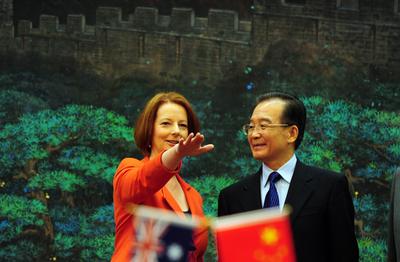In 2009, China’s share of Australian exports was more than three times its world import share China’s competitiveness in manufacturing provides low-cost imported goods for Australia and contributes further to the improvement in Australia’s terms of trade.
While market forces have driven this deepening relationship, the policy framework in which that has occurred has also been evolving but with less coherence and greater variability. There is insufficient attention to the long run structural change of the Chinese economy. This is evident in a number of recent policy challenges — in foreign investment, visas for students, air transport policy, minerals taxation, domestic reform and structural adjustment in Australia and in the approach to the FTA. These are directly related to key areas of interest in the relationship with China, and the manner in which Australia is responding will affect the evolution of this relationship.
Alongside the growth in trade, Chinese FDI projects surged to more than A$7 billion in 2005–06 and then quadrupled in 2008–09. This occurred in the face of the global financial crisis. Australian policy, however, remains unnecessarily discriminatory approach to approvals of Chinese projects, with concerns about their size and the distribution of benefits of projects. More important to deal with those issues is in Australia a better understanding of and support for the progress of corporate reform in China. But meanwhile, since these capital flows are complementary to trade flows in food and in resources, a restrictive Australian policy also creates opportunities for competitors and risks in the trade growth.
An important feature of the bilateral relationship is the movement of people. In 2006, the Chinese became the largest Asia-born group in Australia, accounting for one per cent of the population. Migrants from China are found in the top-three occupational categories in terms of skills (managers and professionals), underlining the extent to which students from China in Australia transfer to permanent residence. A critical policy response in Australia, that had become an impediment, was the treatment of international student visas. Migration risk — the risk that people arriving in Australia will not abide by the conditions of their visa — has been driving policy on visas. The concern was that people apparently arriving for one purpose, such as study, might actually have in mind another goal, such as work or settlement. Following the Knight Review of these policies a number of changes have been made to speed up processing times, reduce the financial requirements and make it easier to work. Research by Philippa Dee shows student flows are highly sensitive to these regulatory matters and it will be important to monitor future students in response to these changes.
Tourism is also growing in both directions. China is likely to become number one in terms of the number of arrivals and their expenditure within a few years. Chinese ‘visitors’ now spend more nights in Australia than arrivals from any other country. A critical policy issue for Australia in this sector is the treatment of air transport services between Australia and China. Australia has committed itself to the ‘ultimate objective’ of an open-capacity arrangement with China but currently capacity levels are capped. These have increased from 14,500 seats a week in 2010 to 18,500 in March 2011, and 22,500 in February 2012. A more liberal approach to aviation will be important, also because of the scope to offer services beyond China to Europe.
A more commonly discussed challenge for Australia is to manage the minerals and energy boom. The prospect is after a period of high prices, supply will increase and prices will fall again, though not necessarily to the pre-boom levels. These price swings create opportunities for Australia in the short term but also significant structural change, especially in the rest of the economy which is exposed to international competition. Important in this situation are further reforms to add flexibility in the economy and to contribute to productivity growth in the sectors being squeezed. The more immediate policy response was not focused on these questions but on taxation of mineral rents. This led to a series of policy changes and a new system, in which it is still not clear whether the fundamental problems of the preceding royalty arrangements have been resolved.
Meanwhile, the structure of the Chinese economy is shifting and offers the scope for a series of new business opportunities for Australia. The extent to which they can be captured, in services, for example, depends in part on the features of the trading system that links the two economies. Negotiations on an FTA are attempting to shift that system but so far with little progress. A new focus — on structural changes in China and the prospects they offer, and on current issues in regulatory systems in Australia — might provide more productive avenues of discussion.
Professor Christopher Findlay is Executive Dean of the Faculty of the Professions at the University of Adelaide. Professor Findlay’s research was presented at China Update 2011. The annual China Update conference is hosted by the China Economy Program, in collaboration with the East Asia Forum, at the ANU in July.
This article is a digest of Professor Findlay’s chapter, ‘Australia–China Economic Relations’, in Jane Golley and Ligang Song (eds), Rising China: Global Challenges and Opportunities (ANU E Press, 2011), available in pdf here. This book is the latest publication in the China Update Book Series, launched at the China Update conference every year.

